 |
 |
 |
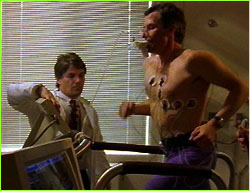 From Sea Level to Base Camp
From Sea Level to Base CampPage 2 | Back to Page 1 VO2 MAX VO2 MAX (calculated in cubic centimeters of oxygen per kilogram of body weight per minute), measures a person's maximum oxygen consumption—how much oxygen their bodies are able to burn when they're exercising vigorously. For this test, each climber must run on a treadmill until the point of exhaustion. The treadmill is slowly calibrated to an incline, simulating an uphill ascent with a 9% grade. An electrocardiogram measures blood pressure and heart rate while the treadmill measures speed, grade of incline, and time. "10 or 15 years ago," Dr. Schoene comments, "we thought that the elite high-altitude climber had to have these extraordinarily high V02 MAX's, like the elite long-distance runner who reaches 60, 70, or 80 cc's of oxygen per kilogram of body weight per minute. Some high-altitude climbers are in that range, but there are those who aren't who succeed just as well." The VO2 MAX test also helps experts estimate a person's endurance. Dr. Schoene says, "We can infer from the maximum exercise test, which takes 10 or 15 minutes, under what percentage of that maximum someone can operate—not for a minute or two—but for hours or even days. In the normal population, that break point is about 55 to 60% of their maximum oxygen consumption." Dr. Schoene has observed that people who perform extraordinarily well at altitude can function for a long time at a high percentage of that maximum oxygen consumption (VO2 MAX). "So that person can trudge through the snow, break trail, climb up a cliff at 85% of their maximum capability for hours; that's the characteristic that I think is really extraordinary." 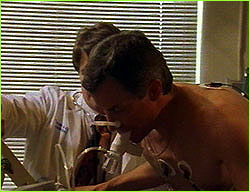 When Breashears finally takes off his mask after reaching the point of
exhaustion, he says, "This is what it's like to be—every step—at 26,000
feet; you feel like this." Dr. Schoene asks, "What gave out, your breathing or
your legs or your head?"
When Breashears finally takes off his mask after reaching the point of
exhaustion, he says, "This is what it's like to be—every step—at 26,000
feet; you feel like this." Dr. Schoene asks, "What gave out, your breathing or
your legs or your head?" "Well, really, I just said I don't have to do this." "Total shut down?" "The legs were okay." "Really?" "Okay, a little burning. It was general all around break down." "David, do you think you could say that at altitude you'd want to go further?" "Yeah. When you stop at altitude for rest, you feel like you're basically dead and sit down. Five minutes later, you have the will to take another five steps. It's that kind of ability to block out all that pain that allows us to keep going back up, year after year. Or some level of stupidity. Who knows what it is." What we do know from past experience is that athletes like Breashears and Viesturs clearly possess some immeasurable factors that allow them to perform well in an oxygen-deficient environment—experience, judgment, and desire. But the physical characteristics demanded by Himalayan climbing—endurance, breathing response, lung capacity, and heart response—may well be the additional key factors that determine how well a climber can perform at high altitude. Dr. Schoene tells us, "Most people who have done well at extreme altitude have these characteristics. So far it looks like that's true in the climbers we've studied today." (Viestur's V02 MAX was 67 cc/kg/min O2 consumption, Breashears logged in at 58, and Carter at 49.6—all above normal.) Neuro-Behavioral Tests In another room we find David Carter with Psychometrist Gail Rosenbaum and expedition physician Dr. Howard Donner. For years, specialists have asked how altitude might affect one's cognitive abilities, but very few tests have been conducted up high. Rosenbaum has put together a battery of neuro-behavioral tests for Dr. Donner to conduct on the climbers as they ascend Everest. Rosenbaum's work with hypoxic (oxygen-deprived) patients at sea level, has shown that they suffer from memory loss, and have difficulty solving problems. The tests she has devised will help measure whether the same effects begin to show up in our climbers as they ascend. En Route To Everest Base Camp 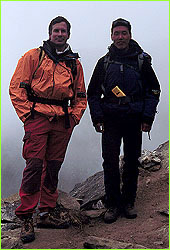 After three days of waiting to fly from Kathmandu to Lukla—and just when
our helicopter is ready for flight—the clouds close in over our heads and
dump another unseasonable load of rain. Normally, the monsoon arrives in May,
but perhaps this year it's come early. Our expedition Sirdar (Sherpa leader) is
Jangbu Sherpa, a 24-year old climbing Sherpa who summited Everest last year
with Breashears on the IMAX filming expedition. He counts our loads waiting to
be put on the helicopter; there are only 30, as the remaining 70 have already
been flown up into the Khumbu and are waiting with the rest of our Sherpa
expedition staff.
After three days of waiting to fly from Kathmandu to Lukla—and just when
our helicopter is ready for flight—the clouds close in over our heads and
dump another unseasonable load of rain. Normally, the monsoon arrives in May,
but perhaps this year it's come early. Our expedition Sirdar (Sherpa leader) is
Jangbu Sherpa, a 24-year old climbing Sherpa who summited Everest last year
with Breashears on the IMAX filming expedition. He counts our loads waiting to
be put on the helicopter; there are only 30, as the remaining 70 have already
been flown up into the Khumbu and are waiting with the rest of our Sherpa
expedition staff. We fly up to Lukla at an altitude of 8,000 feet. After the dusty streets of Kathmandu down at 4,000 feet, the thin air of the mountains hits you. You breathe more frequently and your heart rate increases a little as you trip along the trail to Namche Bazaar at 11,400 feet. We stay for one night in Namche and then move up to Khumjung, some 300 feet higher. 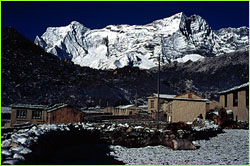 Yak bells ring us awake in Khumjung, one of the oldest Sherpa villages
in Nepal. We're just enough off the beaten path to avoid the throngs of
trekkers. Expedition member Pete Athans, a four-time summiter of Everest,
considers Kumjung his home away from Boulder, Colorado. This is where he
married his wife, Liz Green, in a traditional Sherpa-style wedding that lasted
two days. This year he's back to be our digital cameraman on Everest,
assisting David with the filming on the mountain.
Yak bells ring us awake in Khumjung, one of the oldest Sherpa villages
in Nepal. We're just enough off the beaten path to avoid the throngs of
trekkers. Expedition member Pete Athans, a four-time summiter of Everest,
considers Kumjung his home away from Boulder, Colorado. This is where he
married his wife, Liz Green, in a traditional Sherpa-style wedding that lasted
two days. This year he's back to be our digital cameraman on Everest,
assisting David with the filming on the mountain. 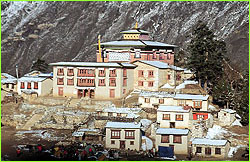 We move upwards through the clouds toward Thyangboche Monastery. The
weather turns bad, and the snowy slopes of Ama Dablam are obscured by the mists
of an oncoming afternoon cloud bank. Our walk from the Dudh Kosi river up the
steep switchbacks of Thyangboche hill ends in a full snow storm, with no
visibility and no available rooms left in Thyangboche, so we must move on—down the hill to Deboche.
We move upwards through the clouds toward Thyangboche Monastery. The
weather turns bad, and the snowy slopes of Ama Dablam are obscured by the mists
of an oncoming afternoon cloud bank. Our walk from the Dudh Kosi river up the
steep switchbacks of Thyangboche hill ends in a full snow storm, with no
visibility and no available rooms left in Thyangboche, so we must move on—down the hill to Deboche.Continue: A Visit from Sir Edmund Hillary Lost on Everest | High Exposure | Climb | History & Culture | Earth, Wind, & Ice E-mail | Previous Expeditions | Resources | Site Map | Everest Home Editor's Picks | Previous Sites | Join Us/E-mail | TV/Web Schedule About NOVA | Teachers | Site Map | Shop | Jobs | Search | To print PBS Online | NOVA Online | WGBH © | Updated November 2000 |